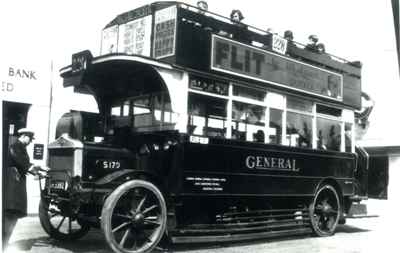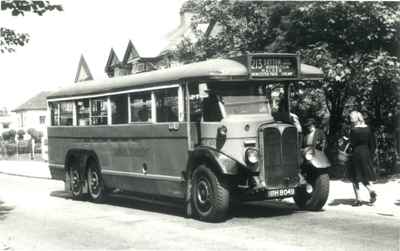Transport history by Derek Fisk
Part 2 - Development
Continued from Part
1
By May 1930 the pace of
house-building in the area prompted the LGOC to recast some local
services. The 164 was rerouted away from North Cheam via Sutton and
Banstead to Epsom and the 70 group became a 10 minute service, with
additional 155s giving 12 bph in the peaks along London Road. From
June 1930 an hourly Green Line service from Dorking to Oxford
Circus was added to this road, which by October had become a 15
minute service, including a 30 minute service from Great
Bookham.
The Queen Victoria
crossroads on 21 Aug 49, looking south, with the pub sign
visible on the left. Merton's STL350 loads for Putney Bridge
Station on the post-war 93.
Photo © Alan Cross
Further enhancement to the red buses came the same month with
the 113 peak service increased to 3 bph, and the 93 service from
Willesden and Putney Bridge extended from Morden to Cheam adding
another 6 bph along London Road. A new working was introduced at
North Cheam in 1934 by shortening the 93 to run through Senhouse
Road and Church Hill Road to Priory Road, returning via Malden Road
to the Queen Victoria. Passengers were carried over the whole
terminal working.
 Although not mentioned by Derek Fisk in his
article, summer route 228 ran from 1930 to 1933, from Morden
via North Cheam and Epsom to Lower Kingswood. In 1932,
it was intended that the route be extended to Redhill
and transferred to London General Country Services, and was
even shown in their timetable, but the transfer did not
happen. Meanwhile, the 406 had run betwen Kingston
and Redhill since 1924. The 228 was operated by Merton,
using double-deck S-class buses in 1930, as S179 seen here at
Morden, and LTs thereafter.
Although not mentioned by Derek Fisk in his
article, summer route 228 ran from 1930 to 1933, from Morden
via North Cheam and Epsom to Lower Kingswood. In 1932,
it was intended that the route be extended to Redhill
and transferred to London General Country Services, and was
even shown in their timetable, but the transfer did not
happen. Meanwhile, the 406 had run betwen Kingston
and Redhill since 1924. The 228 was operated by Merton,
using double-deck S-class buses in 1930, as S179 seen here at
Morden, and LTs thereafter.
Photo from W Noel Jackson collection, ©
Alan Cross
In April 1931 the 70D from Morden to Dorking became a
joint operation between the General and East Surrey, a unique
arrangement in London. The East Surrey buses passed to LGCS in 1932
and to the Country Bus & Coach Department in 1933, after which
they were painted green. This joint operation continued until 1938,
when the country bus service was cut back to Epsom (this later
became the 470 and was extended to West
Croydon). This change came about because the TGWU was disturbed
about the disparity in wage rates between Central and Country
busmen. While the Board argued that the two styles of work were
different, even on country routes that penetrated suburbia, this
distinction was indefensible when the same route number was being
worked by two sets of staff.
Further augmentation occurred early in 1932 with peak hour and
Saturday shorts on the 156A along London Road, running
via Morden to St Helier Avenue. This 24 bph service sufficed until
August 1933 when the new London Transport added a further 6 bph. In
October 1933 the Green Line services were recast with routes D and
H being replaced by the K and L, maintaining 4 bph through North
Cheam. Increased frequencies continued through 1934, reaching 33
bph in the peaks to Morden., while the 113 was now 6 bph in the
peaks.

The 113 became the 213 in
the 1934 renumbering. Nearly four years earlier, the first
Scooter LT1001 emerged from Chiswick and went to work at
Edgware. The class took over the 113 six months later, but it
was some time before LT1001 moved south of the river. By 8
May 48, seen in Cheam Common Road in North Cheam, it is
looking distinctly tired, and was scrapped a year later.
Photo © Alan Cross
The October 1934 bus renumbering scheme saw the 70 lose all its
suffixes while the single deck routes gained numbers in the 200
series. The 113 became the 213, while the
155B changed to 245. In May 1936 Green Line route L was
extended from Uxbridge alternately to Chesham (L1) and High Wycombe
(L2). A year later this was replaced by route O running to Windsor,
but combined with the K1/2 still provided a joint 15 minute service
through North Cheam. Meanwhile steady improvements on local buses
saw them reach a peak of 55 bph (32 offpeak) along London Road by
the end of 1937. Changes in 1938 saw the withdrawal of the 70 in
October, with the extension of the 93 from Morden to Epsom, further
extended on summer Sundays to Dorking. Other changes now brought
the total service on London Road to 48 bph peaks and 18
offpeak.
On the outbreak of war in September 1939, the Green Line
services were immediately withdrawn, although replaced by a half
hourly route 14 Dorking to Victoria from December 1940 to September
1942. Other fuel saving measures, apart from the fixed stop scheme,
saw blackout evening services reduced, or withdrawn completely in
the case if the 245, although the 213 was gradually increased in
the peaks in response to manufacturing efforts and petrol
rationing.
 Fuel shortages also led to a shorter terminal working
at North Cheam. In place of the lengthy Priory Road circuit, buses
initially turned right into Lavender Avenue and left into Farm Way
and Cheam Common Road. However, a much shorter working was then
achieved by negotiating with the Queen Victoria to use the new
rearcourt linked to the Senhouse Road/Church Hill Road junction as
a bus stand and so return to Cheam Road.
Fuel shortages also led to a shorter terminal working
at North Cheam. In place of the lengthy Priory Road circuit, buses
initially turned right into Lavender Avenue and left into Farm Way
and Cheam Common Road. However, a much shorter working was then
achieved by negotiating with the Queen Victoria to use the new
rearcourt linked to the Senhouse Road/Church Hill Road junction as
a bus stand and so return to Cheam Road.
The stand at the rear of the Queen
Victoria. On 1 May 1948, this was the terminus of the
5A, on which Camberwell's ST13 is working but displaying
a route number only on the side plate, and the 151 to Carshalton
Culvers Avenue (aka Hackbridge Reynolds Close),
which features Sutton's D235. The 151 again works between
North Cheam and Carshalton, but via a completely different route
and having had various incarnations in between.
Photo © Alan Cross
From January 1941 lowbridge double deck buses were first used on
a Central Bus route by converting the 245 to the 127. This virtually doubled the capacity with the
same frequency, initially using loaned Manchester Corporation buses
and a few single deckers. Other wartime developments saw two new
routes along London Road in February 1942, with the extension of
the 5A from South Wimbledon to North Cheam and the 151
from Hackbridge and Morden to North Cheam. The 93 was also
increased and a service was restored to Priory Road in April
1944.
Continued in Part
3